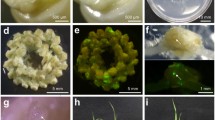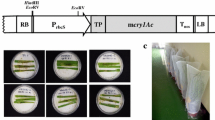Summary
A synthetic Bt gene encoding a truncated version of the CryIA(b) protein derived from Bacillus thuringiensis was successfully introduced into elite maize using microprojectile bombardment of immature embryos. The method used to initiate and identify transformation events is described. We describe the detailed parameters used for the Biolistics device as well as the plasmids used for the transformations. The plasmids contained the synthetic Bt gene driven by either the 35S CaMV promoter or a combination of two tissue-specific promoters, leaf and pollen, derived from maize. Specific conditions for the culture of Type I callus from immature embryos, the phosphinothricin (PPT) selection protocol, and the regeneration of plants are discussed. T0 and T1 plants were initially identified using the pH-dependent chlorophenol red test and/or the histochemical β-glucuronidase (GUS) assay. PCR and Southern data confirm the presence of the 35S CaMV promoter and the synthetic Bt gene.
Similar content being viewed by others
References
Clark M.F., R.M. Lister & M. Bar-Joseph, 1986. Elisa Techniques. Methods Enzymol. 118: 742–766.
Duncan D.R., M.E. Williams, B.E. Zehr & J.M. Widholm, 1985. The production of callus capable of plant regeneration from immature embryos of numerous Zea mays genotypes. Planta 165: 322–332.
E.I. du Pont de Nemours & Co., 1990. Biolistic PDS-1000 Particle Delivery System. Wilmington, DE.
Fromm M.E., F. Morrish, C. Armstrong, R. Williams, J. Thomas & T.M. Klein, 1990. Inheritance and expression of chimeric genes in the progeny of transgenic maize plants. Bio/Technology 8: 833–839.
Gamborg O., R. Miller & K. Ojima, 1968. Nutrient requirements of suspension cultures of soybean root cells. Exp. Cell Res. 50: 151–158.
Genovesi, D., N. Willetts, S. Zachwieja, M. Mann, T. Spencer, C. Flick & W. Gordon-Kamm, 1992. Transformation of an elite maize inbred through microprojectile bombardment of regenerable embryogenic callus. In Vitro Cell Dev. Bio. 28: 124A.
Gordon-Kamm W.J., T. Spencer, M. Mangano, T. Adams, R. Daines, W. Start, J. O'Brien, S. Chambers, W. Adams, N. Willetts, T. Rice, C. Mackey, R. Krueger, A. Kausch & P. Lemaux, 1990. Transformation of maize cells and regeneration of fertile transgenic plants. The Plant Cell 2: 603–618.
Jefferson R.A., 1989. The GUS gene fusion system. Nature 342: 837–838.
Koziel M., G. Beland, C. Bowman, N. Carozzi, B. Crenshaw, L. Crossland, J. Dawson, N. Desai, M. Hill, S. Kadwell, K. Launis, K. Lewis, D. Maddox, K. McPherson, M. Meghji, E. Merlin, R. Rhodes, G. Warren, M. Wright & S. Evola, 1993. Field performance of elite transgenic maize plants expressing an insecticidal protein derived from Bacillus thuringiensis. Bio/Technology 11: 194–200.
Kramer C., J. DiMaio, G. Carswell & R. Shillito, 1993. Selection of transformed protoplast-derived Zea mays colonies with phophinothricin and a novel assay using the pH indicator chlorophenol red. Planta 190: 454–458.
Murashige T. & F. Skoog, 1962. A revised medium for rapid growth and bioassays with tobacco tissue cultures. Physiol. Plant 15: 473–479.
Perkin Elmer Cetus, 1991. Protocol for DNA amplification. Perkin Elmer Cetus Instruments, Norwalk, CT.
Potrykus I., 1990. Gene transfer to cereals: an assessment. Bio/Technology 8: 535–542.
Sambrook, J., E.F. Fritsch & T. Maniatis, 1989. Molecular Cloning: A Laboratory Manual, Second edition. Cold Spring Harbor Laboratory Press.
Songstad, D., K. Lowe, S. Betz & J. Cabrera-Ponce, 1992. Callus cultures as alternative target tissues in microprojectile bombardment. Agronomy Abstracts, p. 198.
Tomes D.T., 1985. Cell culture, somatic embryogenesis and plant regeneration in maize, rice, sorghum and millet. In: S.W.J. Bright & M.G.K. Jones (Eds). Cereal Tissue and Cell Culture, pp. 175–203. Martinus Nijhoff/Dr. W. Junk Publishers, Dordrecht.
Walters D.A., C.S. Vetsch, D.E. Potts & R.C. Lundquist, 1992. Transformation and inheritance of a hygromycin phosphotransferase gene in maize plants. Plant Molec. Bio. 18: 189–200.
Weymann K., K. Urban, D. Ellis, R. Novitzky, E. Dunder, S. Jayne, D. Murray, G. Jen & G. Pace, 1993. Isolation of transgenic progeny of maize by embryo rescue under selective conditons. In Vitro Cell Dev. Biol. 29: 33–37.
Author information
Authors and Affiliations
Rights and permissions
About this article
Cite this article
Hill, M., Launis, K., Bowman, C. et al. Biolistic introduction of a synthetic Bt gene into elite maize. Euphytica 85, 119–123 (1995). https://doi.org/10.1007/BF00023939
Issue Date:
DOI: https://doi.org/10.1007/BF00023939




